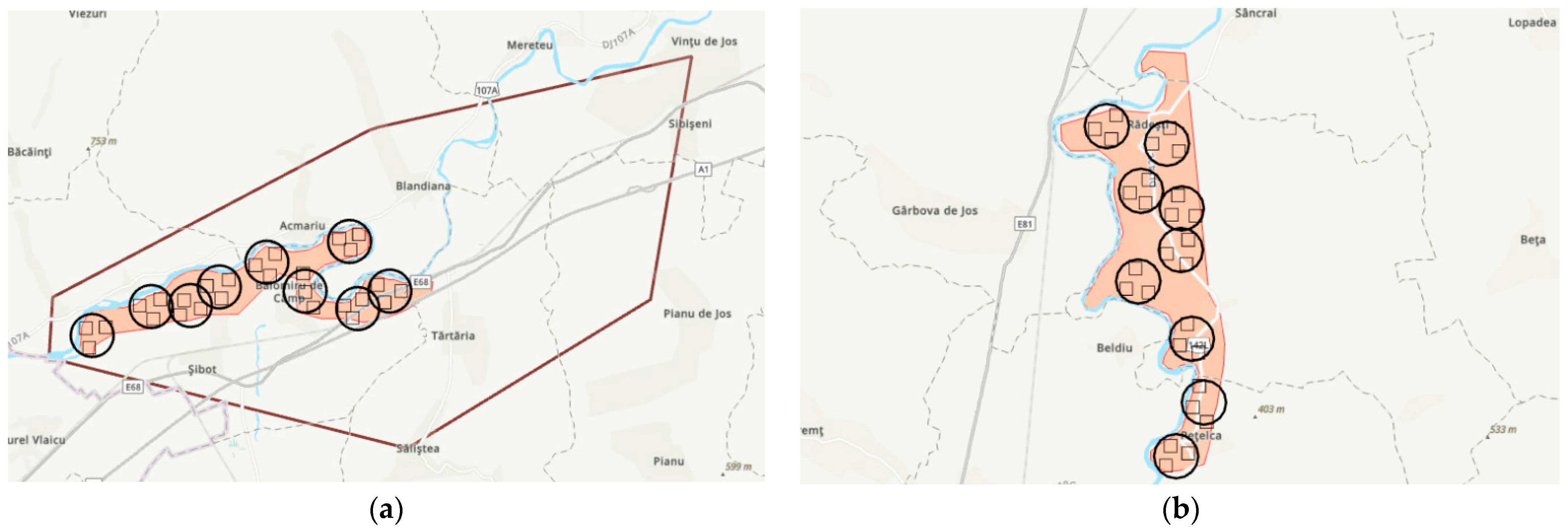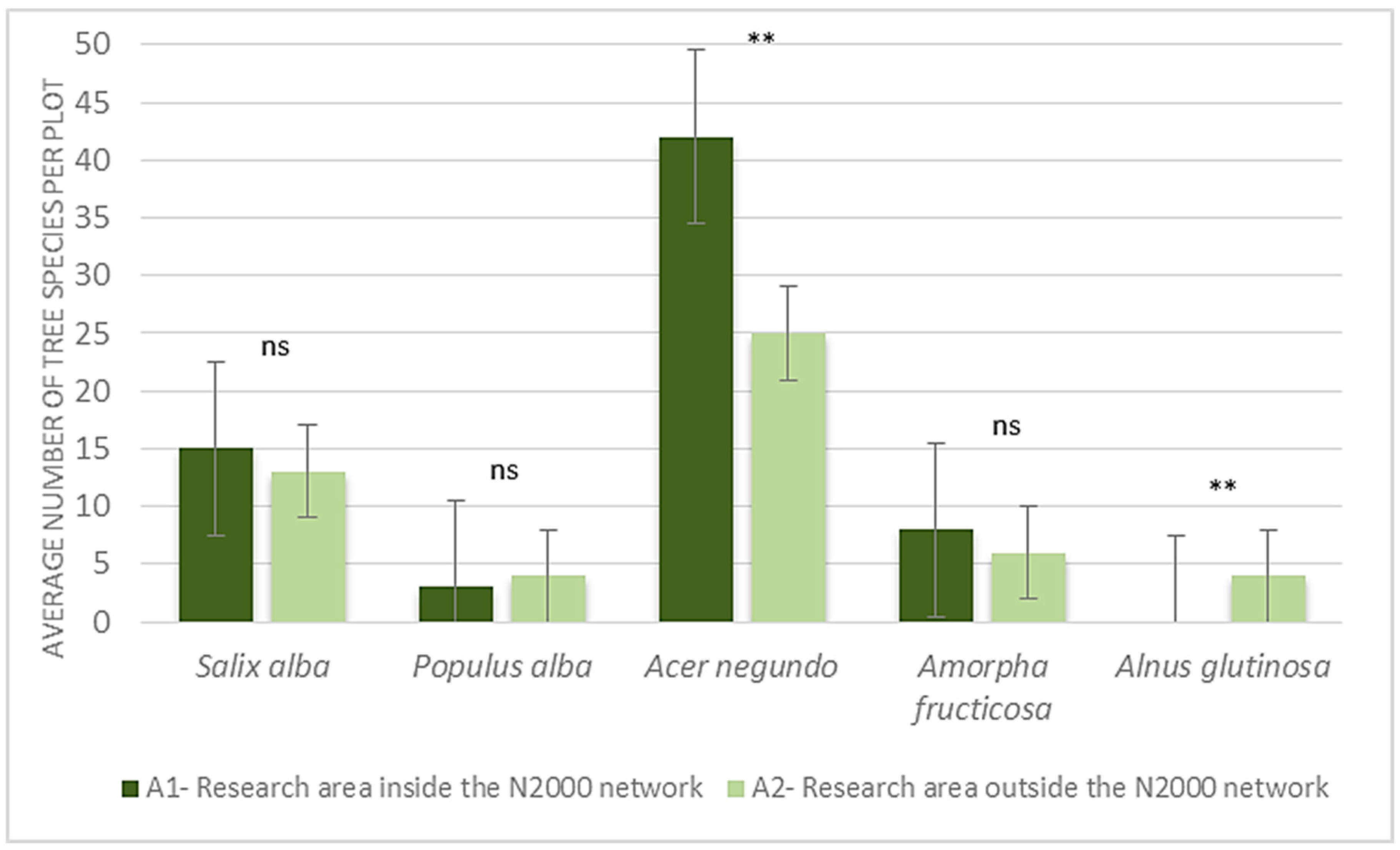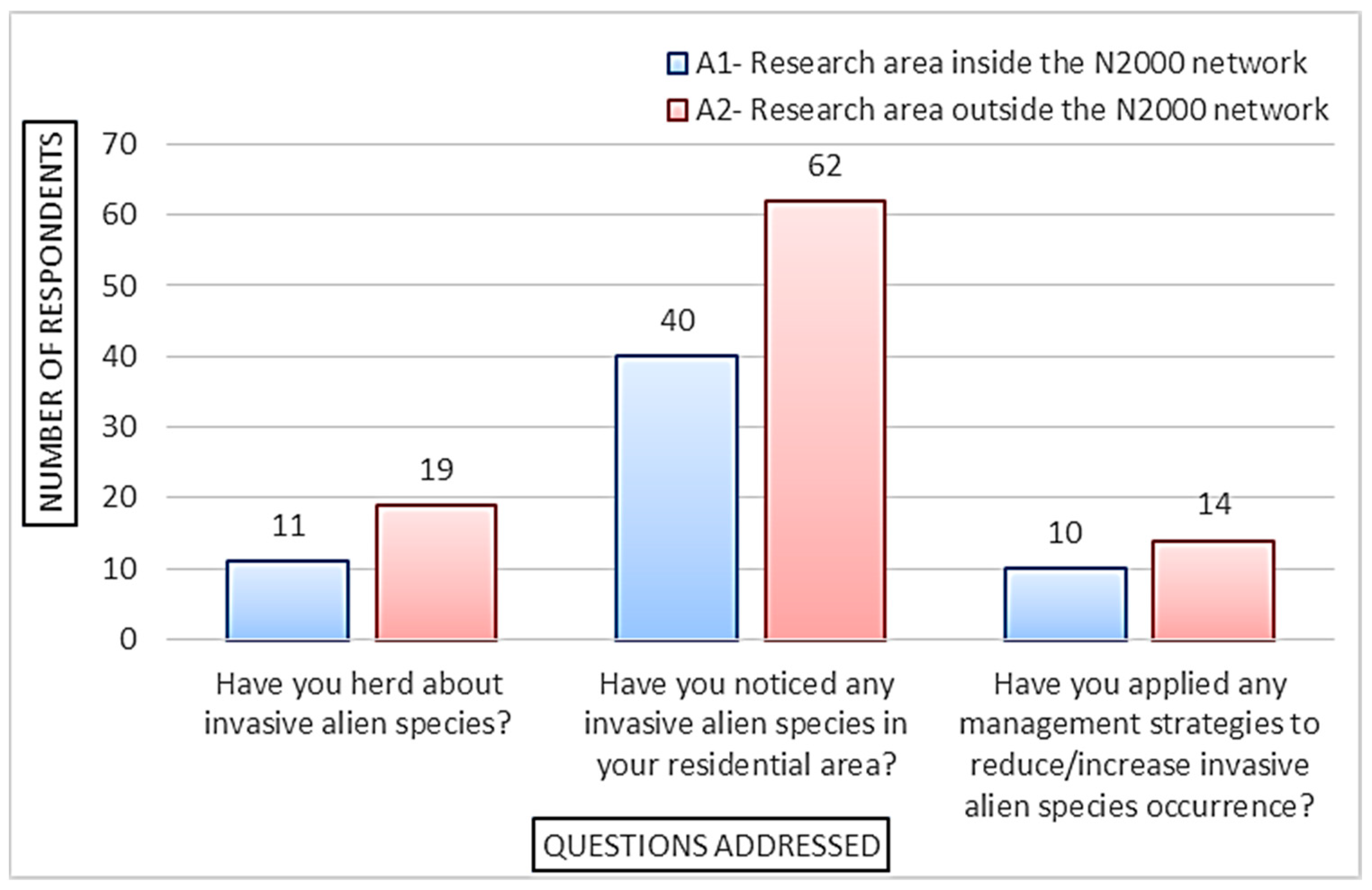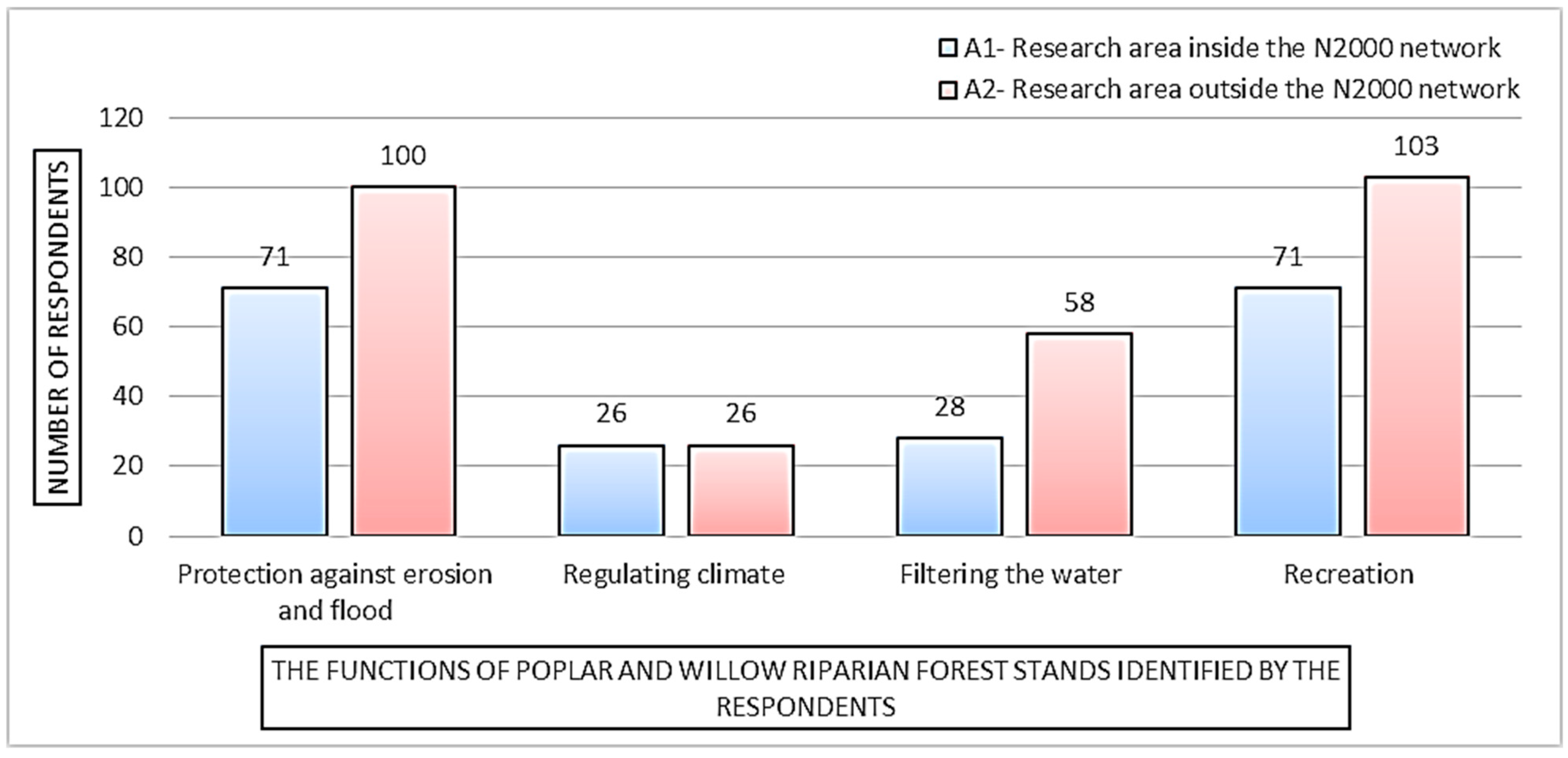The Effectiveness of Natura 2000 Network in Conserving Salix alba and Populus alba Galleries against Invasive Species: A Case Study of Mureșul Mijlociu—Cugir Site, Romania
Abstract
1. Introduction
2. Materials and Methods
2.1. Research Area Description
2.2. Tree Species Diversity
2.3. Effect of N2000 in Conserving Poplar and Willow Galleries against IAS
2.4. Local People Knowledge and Contribution to IAS Occurrence and Overall Conservation of Poplar and Willow Forests
2.5. Data Statistical Analysis
3. Results
3.1. Tree Species Diversity
3.2. Effect of N2000 in Conserving Poplar and Willow Galleries against IAS
3.3. Local People Knowledge and Contribution to IAS Occurrence and Overall Conservation of Poplar and Willow Forests
4. Discussion
5. Conclusions
Author Contributions
Funding
Data Availability Statement
Acknowledgments
Conflicts of Interest
References
- Chivian, E.; Bernstein, A. How Our Health Depends on Biodiversity, 1st ed.; Center for Health and the Global Environment, Harvard Medical School: Cambridge, MA, USA, 2010; pp. 2–3. [Google Scholar]
- European Commission. Proposal for a Regulation of the European Parliament and of the Council on Nature Restoration. Brussels. 22 June 2022. Available online: https://eur-lex.europa.eu/legal-content/EN/TXT/?uri=COM:2022:304:FIN (accessed on 20 September 2022).
- Harfoot, M.B.J.; Tittensor, D.P.; Knight, S.; Arnell, A.P.; Blyth, S.; Brooks, S.; Butchart, S.H.M.; Hutton, J.; Jones, M.I.; Kapos, V.; et al. Present and future biodiversity risks from fossil fuel exploitation. Conserv. Let. 2018, 11, e12448. [Google Scholar] [CrossRef]
- Newbold, T.; Hudson, L.N.; Hill, S.L.L.; Contu, S.; Lysenko, I.; Senior, R.A.; Purvis, A. Global effects of land use on local ter-restrial biodiversity. Nature 2015, 520, 45–50. [Google Scholar] [CrossRef]
- Tittensor, D.P.; Walpole, M.; Hill, S.; Boyce, D.; Britten, G.L.; Burgess, N.; Yimin, Y. A mid-term analysis of progress towards international biodiversity targets. Science 2014, 346, 241–245. [Google Scholar] [CrossRef]
- CBD (Convention on Biological Diversity). Available online: https://www.cbd.int/sp/targets/default.shtml (accessed on 20 September 2022).
- Orlikowska, E.H.; Svensson, J.; Roberge, J.-M.; Blicharska, M.; Mikusiński, G. Hit or miss? Evaluating the effectiveness of Natura 2000 for conservation of forest bird habitat in Sweden. Glob. Ecol. and Conserv. 2020, 22, e00939. [Google Scholar] [CrossRef]
- CEC (Council of the European Communities) Council Directive 92/43/EEC of 21 May 1992 on the conservation of natural habitats and of wild fauna and flora. Off. J. Eur Communities 66. Available online: http://eur-lex.europa.eu/legal-content/EN/TXT/?uri=CELEX:31992L0043 (accessed on 20 September 2022).
- EPCEU (European Parliament and the Council of the European Union) Directive 2009/147/EC of the European parliament and of the council of 30 November 2009 on the conservation of wild birds. Off. J. Eur Union. Available online: http://eur-lex.europa.eu/legal-content/EN/TXT/HTML/?uri=CELEX:32009L0147&from=EN (accessed on 20 September 2022).
- McKenna, D.; Naumann, S.; McFarland, K.; Graf, A.; Evans, D. Literature Review—The ecological effectiveness of the Natura 2000 Network (ETC/BD report to the EEA), 1st ed.; European Topic Centre on Biological Diversity: Paris, France, 2014; pp. 10–11. [Google Scholar]
- Guerra, C.; Baquero, R.A.; Gutiérrez-Arellano, D.; Nicola, G.G. Is the Natura 2000 network effective to prevent the biological invasions? Glob.Ecol. Conserv. 2018, 16, e00497. [Google Scholar] [CrossRef]
- Jackson, A.L.R. Conserving Europe’s Wildlife: Law and Policy of the Natura 2000 Network of Protected Areas, 1st ed.; Routledge: Abingdon-on-Thames, UK, 2018; p. 6. [Google Scholar]
- Early, R.; Bradley, B.A.; Dukes, J.S.; Lawler, J.J.; Olden, J.D.; Blumenthal, D.M.; Gonzalez, D.; Grosholz, E.D.; Ibáñez, I.; Miller, L.P.; et al. Global threats from invasive alien species in the twenty-first century and national response capacities. Nat. Commun. 2016, 7, 12485. [Google Scholar] [CrossRef]
- Pyšek, P.; Hulme, P.E.; Simberloff, D.; Bacher, S.; Blackburn, T.M.; Carlton, J.T.; Dawson, W.; Essl, F.; Foxcroft, L.C.; Genovesi, P.; et al. Scientists’ warning on invasive alien species. Biol. Rev. 2020, 95, 1511–1534. [Google Scholar] [CrossRef]
- Schnitzler, A.; Hale, B.W.; Alsum, E.M. Examining native and exotic species diversity in European riparian forests. Bio. Conserv. 2007, 138, 146–156. [Google Scholar] [CrossRef]
- Habitat type 92A0 Salix alba and Populus alba galleries Factsheet. Available online: https://forestlife.gr/en/92a0-pliroforiako-deltio/ (accessed on 21 September 2022).
- Devillers, P.; Devillers-Terschuren, J. A classification of Palearctic habitats, 3rd ed.; Council of Europe Publishing (Nature and environment): Strasbourg, France, 1998; pp. 38–39. [Google Scholar]
- Management Plan for the Natura 2000 sites—ROSPA0139 Piemontul Munților Metaliferi—Vințu (Incluzând Rezervația Naturală 2.519 Măgura Uroiului) și ROSCI0419 Mureșul Mijlociu—Cugir. Available online: https://piemontmetaliferi.ro/wp-content/uploads/2021/01/planul-de-management.pdf (accessed on 23 September 2022).
- National Institute of Statistics. Available online: https://insse.ro/cms/ro/content/recens%C4%83minte (accessed on 24 September 2022).
- Gillis, M.D. Canada’s National Forest Inventory (responding to current information needs). Environ. Monit. Assess. 2001, 67, 121–129. [Google Scholar] [CrossRef]
- Manning, A.; Wood, J.; Cunningham, R.; McIntyre, S.; Shorthouse, D.; Gordon, I.; Lindenmayer, D. Integrating research and restoration: The establishment of a long-term woodland experiment in south-eastern Australia. Aust. Zool. 2011, 35, 633–648. [Google Scholar] [CrossRef]
- Shannon, C. A mathematical theory of communication. Bell Syst. Tech. J. 1948, 27, 379–423, 623–656. [Google Scholar] [CrossRef]
- Morris, K.E.; Caruso, T.; Buscot, F.; Fischer, M.; Hancock, C.; Maier, T.S.; Meiners, T.; Müller, C.; Obermaier, E.; Prati, D.; et al. Choosing and using diversity indices: Insights for ecological applications from the German Biodiversity Exploratories. Ecol. Evol. 2014, 4, 3514–3524. [Google Scholar] [CrossRef] [PubMed]
- Pielou, E.C. The measurement of diversity in different types of biological collections. J. Theor. Biol. 1966, 13, 131–144. [Google Scholar] [CrossRef]
- Etikan, I. Comparision of snowball sampling and sequential sampling technique. Biom.Biostat. Int. J. 2016, 3, 55. [Google Scholar] [CrossRef]
- Past 4—The Past of the Future. Available online: https://www.nhm.uio.no/english/research/resources/past/ (accessed on 19 December 2022).
- Vilà, J.L.; Espinar, M.H.; Hulme, P.E.; Jarošík, V.; Maron, J.L.; Pergl, J.; Schaffner, U.; Sun, Y.; Pyšek, P. Ecological impacts of invasive alien plants: A meta-analysis of their effects on species, communities and ecosystems Montserrat. Ecol. Lett. 2011, 14, 702–708. [Google Scholar] [CrossRef] [PubMed]
- Mendoza-Fernández, A.; Martínez-Hernández, F.; Garrido-Becerra, J.A.; Pérez-García, F.J.; Medina-Cazorla, J.M.; Peñas de Giles, J.; Mota, J.F. Is the endangered flora of the Iberian southeast adequately protected? Gaps in the Network of Protected Natural Areas of Andalusia (RENPA): The case of the province of Almería. Acta Bot. Gall. 2009, 156, 637–648. [Google Scholar] [CrossRef]
- Mendoza-Fernández, A.; Pérez-García, F.J.; Medina-Cazorla, J.M.; Martínez-Hernández, F.; Garrido-Becerra, J.A.; Sánchez, E.S.; Mota, J.F. Gap analysis and selection of reserves for the threatened flora of eastern Andalusia, a hot spot in the eastern Mediterranean region. Acta Bot. Gall. 2015, 157, 749–767. [Google Scholar] [CrossRef]
- Dornelas, M.; Gotelli, N.J.; McGill, B.; Shimadzu, H.; Moyes, F.; Sievers, C.; Magurran, A.E. Assemblage time series reveal biodiversity change but not systematic loss. Science 2014, 344, 296–299. [Google Scholar] [CrossRef]
- Pearce, F. The New Wild: Why Invasive Species Will Be Nature’s Salvation, 1st ed.; Beacon Press: Boston, MA, USA, 2015; pp. 13–14. [Google Scholar]
- Marziliano, P.A.; Tognetti, R.; Lombardi, F. Is tree age or tree size reducing height increment in Abies alba Mill. at its southernmost distribution limit? Annals of Forest Science 2019, 76, 17. [Google Scholar] [CrossRef]
- Binkley, D.; Stape, J.L.; Ryan, M.G.; Barnard, H.R.; Fownes, J. Age-related decline in forest ecosystem growth: An individual-tree, stand-structure hypothesis. Ecosystems 2002, 5, 58–67. [Google Scholar] [CrossRef]
- Bridgewater, P.; Rotherham, I.D. A critical perspective on the concept of biocultural diversity and its emerging role in nature and heritage conservation. People Nat. 2019, 1, 291–304. [Google Scholar] [CrossRef]
- Uprety, Y.; Asselin, H.; Bergeron, Y.; Doyon, F.; Boucher, J.-F. Contribution of traditional knowledge to ecological restoration: Practices and applications. Écoscience 2012, 19, 225–237. [Google Scholar] [CrossRef]
- Oliveira, S.S.; Pereira, J.; Santos, P.; Pereira, R. Awareness and Knowledge of Portugal Residents about Natura 2000. Sustainability 2020, 12, 9663. [Google Scholar] [CrossRef]
- Wandersee, J.H.; Schussler, E.E. Preventing plant blindness. Am. Biol. Teach. 1999, 61, 84–86. [Google Scholar] [CrossRef]
- European Commission. Eurobarometer—Attitudes of Europeans towards Biodiversity. Available online: https://europa.eu/eurobarometer/surveys/detail/2194 (accessed on 10 October 2022).
- Rotherham, I.D. Willows in the farming landscape: A forgotten eco-cultural icon. Biodiv. Conserv. 2022, 31, 2495–2513. [Google Scholar] [CrossRef]
- Dömpke, S.; Succow, M. Cultural Landscapes and Nature Conservation in Northern Eurasia; Naturschutzbund Deutschland; AIDEnvironment; The Nature Conservation Bureau: Bonn, Germany, 1998. [Google Scholar]
- Čuda, J.; Rumlerová, Z.; Brůna, J.; Skálová, H.; Pyšek, P. Floods affect the abundance of invasive Impatiens glandulifera and its spread from river corridors. Divers. Distrib. 2017, 23, 342–354. [Google Scholar] [CrossRef]







| Sections | Questions |
|---|---|
| 1. General information | What is your age and gender? |
| Which is your last degree in education? | |
| What is your occupation? | |
| 2. Awareness about Natura 2000 network | Have you heard about the N2000 network? |
| Have you noticed the existence of some N2000 sites around your residential area? | |
| Which is the major purpose of a N2000 site from your knowledge/point of view? | |
| Have you know about the management strategies specific to N2000 sites? If yes, which one/do you apply? | |
| 3. Knowledge regarding the invasive alien species | Did you heard about invasive alien species? |
| Have you noticed any invasive alien species in your residential area? If yes, please name some examples. | |
| How do you appreciate the impact of invasive alien species on native vegetation? | |
| Have you applied any management strategies to reduce/increase invasive alien species occurrence? | |
| 4. Local ecological knowledge regarding the management applied to poplar and willow riparian forests | How do you appreciate the value of poplar and willow riparian forests? |
| Have you benefit of these areas (uses)/how? | |
| Have you noticed any change in species composition of the poplar and willow riparian forests located in the neighborhood of your residential area? If yes, which is the reason of this change, from your perspective? | |
| Have you apply any management strategies to these forests stands? |
| Research Area | Mean Number of Trunks per Plot | Diversity Indices | |
|---|---|---|---|
| Shannon–Wiener Index (H′) | Evenness Index (J) | ||
| A1 Research area inside the N2000 network | 68 ± 7.48 a | 1.02 ± 0.04 b | 0.68 ± 0.30 b |
| A2 Research area outside the N2000 network | 52 ± 3.55 b | 1.34 ± 0.13 a | 0.76 ± 0.07 a |
| p-value | 0.00831 | 0.0016 | 0.0050 |
| Research Area | Tree Species | Mean Percent Tree Species per Plot (%) | Dendrometric Measurements | |||
|---|---|---|---|---|---|---|
| Height (m) | Diameter (cm) | Age (Years) | ||||
| A1 | Native | Salix alba | 22 ± 40 b | 22.5 ± 10.60 b | 26 ± 6 b | 23 ± 4 b |
| Populus alba | 4 ± 1.91 c | 31.66 ± 15.27 a | 47 ± 21 a | 32 ± 11 a | ||
| Invasive | Acer negundo | 62 ± 6.20 a | 11.43 ± 4.21 c | 17 ± 4 c | 16 ± 4 c | |
| Amorpha fructicosa | 12 ± 1.81 c | 1.75 ± 0.70 d | 1 ± 0 d | 9 ± 2 d | ||
| A2 | Native | Salix alba | 25± 3.55 b | 23.38 ± 4.11 a | 28 ± 7 a | 29 ± 7 a |
| Populus alba | 8 ± 2.16 c | 19.5 ± 1.91 a | 11 ± 1 b | 19 ± 2 b | ||
| Alnus glutinosa | 11 ± 3.55 c | 11.15 ± 2.23 b | 9 ± 2 b | 11 ± 1 d | ||
| Invasive | Acer negundo | 48 ± 1.63 a | 11.15 ± 1.13 b | 12 ± 3 b | 12 ± 5 c | |
| Amorpha fructicosa | 8 ± 1.63 c | 1.66 ± 0.81 c | 1 ± 0 c | 6 ± 1 d | ||
| p-value (A1 vs. A2) | Native | 0.436 | 0.303 | 0.080 | 0.186 | |
| Invasive | 0.402 | 0.490 | 0.410 | 0.263 | ||
| p-value (A1 vs. A2) | Overall | 0.368 | 0.321 | 0.158 | 0.242 | |
Disclaimer/Publisher’s Note: The statements, opinions and data contained in all publications are solely those of the individual author(s) and contributor(s) and not of MDPI and/or the editor(s). MDPI and/or the editor(s) disclaim responsibility for any injury to people or property resulting from any ideas, methods, instructions or products referred to in the content. |
© 2023 by the authors. Licensee MDPI, Basel, Switzerland. This article is an open access article distributed under the terms and conditions of the Creative Commons Attribution (CC BY) license (https://creativecommons.org/licenses/by/4.0/).
Share and Cite
Avram, C.M.; Proorocu, M.; Mălinaș, A.; Mălinaș, C. The Effectiveness of Natura 2000 Network in Conserving Salix alba and Populus alba Galleries against Invasive Species: A Case Study of Mureșul Mijlociu—Cugir Site, Romania. Forests 2023, 14, 112. https://doi.org/10.3390/f14010112
Avram CM, Proorocu M, Mălinaș A, Mălinaș C. The Effectiveness of Natura 2000 Network in Conserving Salix alba and Populus alba Galleries against Invasive Species: A Case Study of Mureșul Mijlociu—Cugir Site, Romania. Forests. 2023; 14(1):112. https://doi.org/10.3390/f14010112
Chicago/Turabian StyleAvram, Cristina Maria, Marian Proorocu, Anamaria Mălinaș, and Cristian Mălinaș. 2023. "The Effectiveness of Natura 2000 Network in Conserving Salix alba and Populus alba Galleries against Invasive Species: A Case Study of Mureșul Mijlociu—Cugir Site, Romania" Forests 14, no. 1: 112. https://doi.org/10.3390/f14010112
APA StyleAvram, C. M., Proorocu, M., Mălinaș, A., & Mălinaș, C. (2023). The Effectiveness of Natura 2000 Network in Conserving Salix alba and Populus alba Galleries against Invasive Species: A Case Study of Mureșul Mijlociu—Cugir Site, Romania. Forests, 14(1), 112. https://doi.org/10.3390/f14010112






